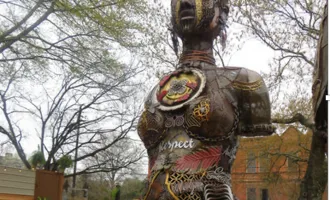
This Date in UCSF History: Reflections on Cinco de Mayo
Originally published in Synapse on May 1, 1976
This coming week is the celebration of Cinco de Mayo and La Semana de la Raza, an event annually sponsored by CHE (Chicanos in Health Education) here at UCSF. Someone new to UCSF might reasonably ask, “What is this Cinco de Mayo all about?” “What is CHE?” and “What is a Chicano for that matter?”
Cinco de Mayo
First of all, the celebration of Cinco de Mayo commemorates the defeat of the French army by Mexican forces at the Battle of Pueblo May 5, 1862.
Maximillian’s modern, well-armed military expedition was decisively defeated by a peasant army fighting for the government of Benito Juarez, a pure blooded Zapotec Indian. The rout of the French in Mexico represents a historical lesson on the folly of foreign adventure by a colonial power, in this case the France of Napoleon III.
The phenomenon of Cinco de Mayo 1862 is classic in the sense that the defeat of puppet regimes of colonial powers by people’s armies is a recurrent theme in history: in the history of our own country in the Revolution, and in our own lifetimes, in Cuba, and even more recently in Vietnam and Cambodia.
These conflicts could never have been won were it not for the strength of will and the sacrifice of the lives of the people. It is clear that no matter how powerful a nation might be, its power is minimal when opposed to the indomitable will of people fighting on its own soil.
If one studies the history of Mexico the threat of foreign political, and economic domination and the role of the will Mestizo masses recur over and over. The attempt of Maximillian was neither the first nor the last.
At first under the centuries of colonial domination by Spain indigenous civilizations were lost to history and the wealth of New Spain was hoarded in Gachupin coffers: and then after the yoke of Spanish subjugation had been thrown off by a peasant revolt started by Hidalgo, Mexico lost a large fraction of its territory now the Southwestern states of the U.S. to “Manifest Destiny.”
The French intervention was the last overt colonialist attempt, but by the end of the nineteenth century neocolonialism had emerged as a more subtle means of determination.
The era of Porfino Diaz, the selling out of Mexican resources to U.S. “robber barons” resulted in the development of smoldering discontent, ended abruptly with the eruption of the Mexican Revolution in 1910, a peasant revolution led by popular heroes like Pancho Villa and Emiliano Zapata.
Taken within the context of this brief sketch of Mexican history, the Battle of Puebla illustrates this continuing struggle of the peoples of underdeveloped countries throughout the world to assert themselves against colonial, neocolonial interests, to protect their right to self-determination, without foreign influence.
It was as recent as the 1960’s in this hemisphere the Partama and the Dominican Republic have been the objects of overt military intervention by the U.S. and Chile has been the object of covert intervention by the CIA.
Chicanismo
For Chicanos in the U.S. today the same issues of self-determination that are celebrated in Cinco de Mayo have relevance. Cinco de Mayo might seem removed from the present, a traditional holiday, but inappropriate since the events of Puebla and 1862 are very far away.
But the significance of Cinco de Mayo for us today might be understood in the context of the present situation of Chicanos, Borinquenos, and other Latin Americans living in the U.S., as well as Blacks, Filipinos, and Asians.
As in 1862, the issue is one of self-determination. In the face of political and economic oppression but instead of colonialism, the means of subordination are what sociologists have described in the model of “internal colonialism.”
Colonialism being defined as the enforced political and economic subordination of the colonized to the advantage of the exploiting colonizer, internal colonialism functions not on an international level but on the community level.
The barrio, or the ghetto for that matter is the internal colony and some examples of exploitative practices are: the higher prices charged for inferior goods and housing by merchants and “slum lords” from outside the barrio; the gerrymandering of election districts; the relegation of trivial political offices to Chicanos, such as justice-of-the-peace; the existence of an educational system which insures that its drop outs will not leave the barrio, thereby perpetuating the internal colony.
The Chicano Movement emerged in the 1960’s in response to the powerlessness felt in the Chicano Community, powerlessness due to what has been conceptualized as the community’s status as an internal colony.
The Chicano movement is of interest to the student of social movements because of its evolution. At first the emphasis was on slogans and rhetoric, and it was an era of the venting of accumulated frustrations and, curiously of a naive optimism.
In effect the flamboyance of that period reflected the collective search for identity showed by a whole generation of young Chicanos, much as their fathers had been identified as Pachucos a generation previously. As the participants in the movement have matured, the movement itself had matured along with them.
The student activists of the 1960’s have gone on, and while the rhetoric has subsided the idealism remains and is being translated into actions and concrete achievements in which they might now truly be said to be “activists.”
That is the stage in the evolution of the Chicano Movement that we as members of CHE are. It remains to be seen what the ultimate culmination of the Chicano movement will be. Time will tell.
As professional students at the present time we wish to encourage our younger brothers and sisters who are now in college, high school, and grade school to join us, to share our goals, and to serve our people — and that, in essence is what Chicanismo is all about.



